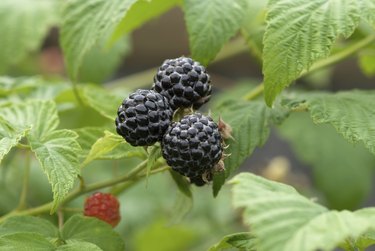
The first settlers in what is now New York, like the Native Americans who preceded them, found a bounty of berries growing wild. Not all wild berries make good human food, but they give color to the garden and attract wildlife. Berries occur mostly on bushes and rambling cane plants, but strawberries are herbaceous, low-growing perennials. Edible wild berries may not give as many fruits, or fruits as large as similar horticultural species, varieties or hybrids, but they often have a unique, unmatched flavor all their own.
Strawberries
Video of the Day
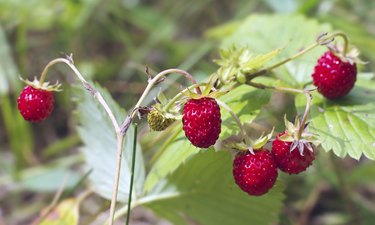
Two species of wild strawberry grow in New York. Scarlet strawberry (Fragaria virginiana) prefers partial shade to full sun, growing to 1 foot tall and hardy in U.S. Department of Agriculture plant hardiness zones 3 through 7. It has small, sweet, juicy, fruit. Wood strawberry (Fragaria vesca) grows primarily in woods and forests in New York and prefers shaded conditions and moist soils, and it also grows wild throughout most of the Northern Hemisphere. It is hardy in USDA zones 4 through 8. The small, sweet strawberries occur from early summer until frost. They are reputed to have a taste superior to that of cultivated strawberries.
Video of the Day
Cane Berries
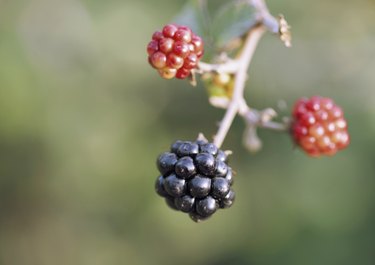
Borne on rambling, thorny canes, black raspberries (Rubus occidentalis) and common blackberry (Rubus allegheniensis) are native to New York, both hardy in USDA zones 3 through 7. Black raspberries have small but tasty fruits produced on arching, 8-foot-long canes that can reroot where they touch ground, forming a dense thicket. Common blackberry fruits have a sweet, slightly spicy taste. Ripe blackberries are dull rather than glossy. Manage blackberry plants each year so you have good access and you control their spread. Remove dead canes, cut live canes back to 6 or 8 feet long in spring or fall, and give plants a 6-inch-deep layer of mulch.
Shrubs With Edible Berries
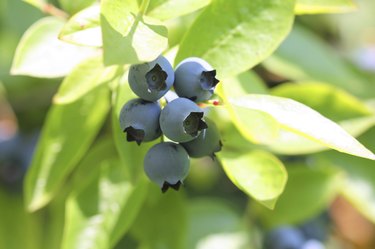
Two types of blueberries (Vaccinium spp.) grow wild in New York. Highbush blueberries (Vaccinium corymbosum) are about 6 feet tall and grow in USDA zones 4 through 7. Lowbush blueberries are 8 to 18 inches tall and hardy in USDA zones 3 through 6. Plant highbush blueberries 6 feet apart and lowbush blueberries 2 feet apart, providing the plants with a 3-inch-deep mulch layer. The fruits ripen in summer months. A tall bush with dark purple fruits, serviceberry, also known as Juneberry (Amelanchier canadensis), inhabits eastern North America. Hardy in USDA zones 4 through 8, shrubs exhibit golden yellow fall color. Use the fruit for jellies, pies and jams. If you intend to harvest berries for food, before adding it to your garden, make sure of its identity and that it is indeed safe to eat.
Other Berries
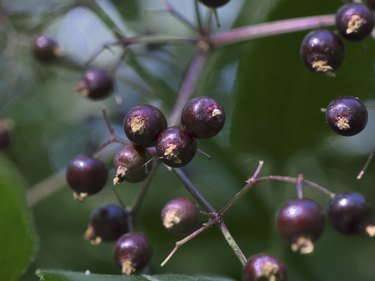
A shrub that adds value with its flattened clusters of white flowers in summer, American elderberry (Sambucus canadensis) produces many small, purple-black fruits in the fall. Usually a multi-trunked bush to 12 feet tall, elderberry can be pruned to shorter heights. Wildlife relish the fruits. Another large shrub, highbush cranberry (Viburnum opulus var. americana), is related to elderberries but not to edible cranberries (Vaccinium macrocarpon), which grows in USDA zones 2 to 6. Highbush cranberry, which is hardy in USDA zones 2 through 7, also produces ornamental flowers, with 3- to 4-inch-wide clusters of small white flowers at branch ends. Bright, glossy, red fruits ripen in fall, and often last into the winter.
- Plants for a Future: Fragaria Virginiana - Duchesne.
- U.S. Forest Service: Fragaria Vesca
- Plants for a Future: Fragaria Vesca "Semperflorens" - L.
- Brooklyn Botanic Garden: Mistaken Identity
- New York Times: Urban Forager: It's Prime Time for Black Raspberries
- Plants for a Future: Rubus Allegheniensis - Porter.
- Mother Earth News: Plant Low-maintenance Blackberries
- Plants for a Future: Rubus Occidentalis - L.
- Organic Gardening: Blueberries
- Missouri Botanical Garden: Amelanchier Canadensis
- Fine Gardening: American Elder Sambucus Canadensis
- The Christian Science Monitor: Grow Cranberries in Your Home Garden
- Cornell University: Minor Fruits: Highbush Cranberries